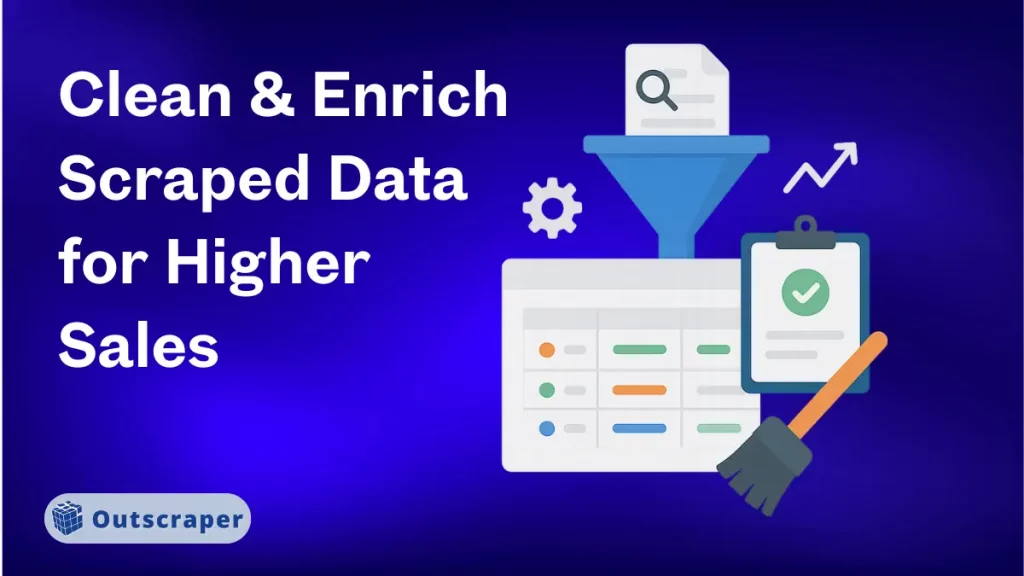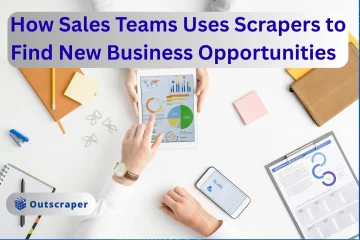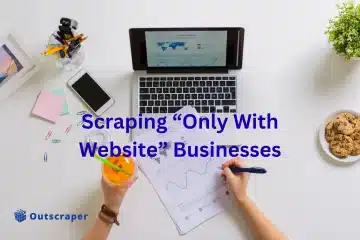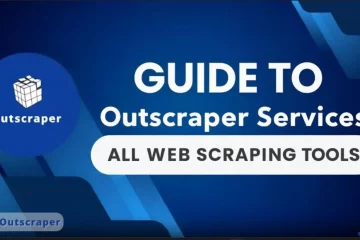Table of Contents
If you need higher sales conversion from scraped data, you should be ready to transform your messy data by following a process of cleaning, enriching, and segmenting.
We’ve all been there. You spend hours scraping the web, collecting what you think is valuable data, but later on, you’ll discover it’s a hot mess. Some emails bounce, phone numbers are disconnected, and the company names are misspelled.
This experience is not only frustrating but definitely a conversion killer.
The truth is that most scraped data fails to convert for one simple reason: it’s messy, outdated, and incomplete. In fact, a shocking 30% of B2B data decays yearly.
But what if you could change that?
In this article, you’ll discover a step-by-step guide to transforming raw, unorganized data into a clean, enriched list of high-quality, sales-ready leads. We’ll show you exactly how to verify, normalize, and append your data so you can boost your conversion rates and close more deals.
Why Cleaning & Enriching Scraped Data is Mandatory
To understand further, your data is just like your pile of laundry. At first glance, it might look clean, but if you don’t sort out the socks and remove the stains, you’ll end up with a messy, unusable pile of laundry. The same goes for your data. If you don’t clean and enrich it, you’re building your sales strategy on a faulty foundation.
What is the biggest culprit? The simple answer is Data decay.
Data decay is not just a few typos; it is the natural and rapid decline in the accuracy of your contact information. Some people change jobs, and some email addresses become inactive. Your seemingly perfect list, which you built a few months ago, is already full of outdated emails, old phone numbers, and messy leads.
So, what happens when you use this messy data? Poor data hygiene leads to wasted effort, low conversions, and missed revenue.
- Low Response Rates: You’re not reaching the right people. An email sent to an outdated address is not only a lost opportunity but a failed outreach effort.
- Wasted Ad Spend: If you use your data for targeted ads, you’re probably paying to show ads to people who no longer work at that company or whose contact information is wrong.
- Missed Revenue: When you’re not connecting with the right decision-makers, you’re not generating new business.
Here’s a concrete example: If you send 1,000 personalized emails to a dirty, uncleaned list. Based on the data decay of 30%, you’re losing at least 300 emails. That’s 300 wasted minutes, 300 lost opportunities, and 300 potential customers you’ll never reach.
Step 1 - Clean Your Scraped Data (Data Hygiene Best Practices)
This is your first step to organizing. You have to get rid of the junk and make sure everything is in its proper place. This is exactly what you’re going to do with your scraped data.
1. Remove Duplicates & Standardize Formats
The first and most critical step is to get rid of duplicates. Why? Because duplicates don’t just clutter your list; they cause chaos with your CRM. If you don’t get rid of duplicates, your sales rep might reach out to the same person three times, or worse, call two different people at the same company with the same pitch. It looks unprofessional, wastes time, and confuses your team.
Solutions & Tools:
- Manual: For smaller lists, you can use built-in functions in Excel or Google Sheets to quickly remove duplicate rows.
- Automated: For larger datasets, tools like Outscraper have built-in cleaning functions that can automatically detect and remove duplicates for you.
2. Verify & Validate Contact Information
A contact isn’t a lead if you can’t contact them. It sounds simple, but you’d be surprised how many lists are full of fake, expired, or misspelled email addresses. Sending emails to these addresses will not only fail to convert but also hurt your sender reputation.
Tools for the Job:
- Email Verification: Services like ZeroBounce or Outscraper’s Email Verifier check each email address to see if it’s valid, deliverable, and not a spam trap.
- Phone Validation: Use specialized tools to check if phone numbers are active and correctly formatted. Outscraper offers Phone Number Enricher. This prevents reps from wasting time on disconnected lines.
3. Fix Incomplete & Inconsistent Fields
The last thing to tackle is inconsistent data. One entry might list “Software Development” while another lists “Software Deve” or just “SaaS.” The same goes for job titles. One might be CEO and another CMO. This makes it impossible to segment your list or run effective, personalized campaigns.
Possible Tools & Solution:
- Normalize Data: Use simple find-and-replace scripts in a spreadsheet or a dedicated data-cleaning service to normalize industry names, job titles, and locations.
- Enrichment APIs: For the most comprehensive cleaning, you can use enrichment APIs. While this is a step ahead, some APIs can not only provide missing information but also correct inconsistencies automatically by cross-referencing with their databases.
Google Maps Scraper
Automate your Google Maps data collection. Export to CSV, Excel, or JSON in just a few minutes!
Step 2: Enrich Your Scraped Data (Make It Sales-Ready)
Now that you’re data is clean, it’s time to make it truly useful. Using data enrichment it will give your cleaned-up data by adding layers of context, intelligence, and insight that a basic scrape just can’t provide. At this stage, you will transform a simple list of contacts into a targeted, actionable list of Ideal Customer Profiles (ICPs).
Add Missing Firmographics
Firmographics are to companies what demographics are to people. They are the characteristics that describe an organization, such as company size, annual revenue, industry, and location. When you scrape data, you often get the company name, but very little else. Adding these details is critical.
Append Technographics & Buyer Intent Signals
To get an edge, you need to know what tools your prospects are already using. Technographics is the data that tells you what technology a company has in its stack. You can check whether they are using your competitor’s software or if they use a specific CRM you integrate with.
Even more powerful are buyer intent signals. These are clues that a company is actively in the market for a solution like yours. This could be anything from recent funding rounds, a surge in job postings or a specific role, or public news about a new project.
This is very important because this data helps you time your outreach for maximum impact. Instead of a cold call, you can reach out and say, “I saw you recently raised a Series B round and are hiring for a Head of Marketing. I thought this might be a good time to discuss how our software can help you scale your team.”
Social and Contact Enrichment
Your scraped list likely has a name and an email, but what about their digital footprint? Adding social profiles like from professional networks and micro-blogging sites provides context and new avenues for engagement. You can see their recent posts, find out who they connect with, and even identify other key decision-makers at the company.
Why it matters is because of the fact that multi-channel outreach is proven to be more effective than relying on a single method. By enriching your contact data with social information, you can connect with prospects where they are most active. This helps build rapport, establish credibility, and create a more personalized, human connection.
Emails & Contacts Scraper
Find emails, contacts, and socials of companies that matter to you.
Step 3: Segment & Score Your Enriched Data
You’ve cleaned your data. You’ve been enriched with tons of valuable information. Now, you have valuable data, but it’s still just a list. The final, crucial step is to organize and prioritize it so your sales team knows exactly who to contact first.
The Importance of ICP Alignment
Your Ideal Customer Profile (ICP) is the blueprint of your perfect customer. It’s not just about demographics; it’s the specific type of company that gets the most value from your product. Your ICP needs to have a high retention rate, and is most likely to expand its business with you.
Before you do anything else, you need to align your newly enriched data with your ICP. Why? Reaching out to a company that’s not a good fit is a waste of time and resources for everyone involved.
Lead Scoring Models
Not all leads are created equal. Lead scoring is a system that assigns a value (or a “score”) to each lead based on how likely they are to become a paying customer. You can create your own scoring model based on the data you’ve enriched.
- Firmographics: Does the company fit your ICP’s industry or size? Give them points.
- Job Role: Is the contact a key decision-maker like a CEO, VP, or Director? Give them a high score.
- Buying Signals: Did you find a recent funding announcement or a surge in hiring? This indicates a high level of intent, so give them a huge score.
By implementing a lead scoring system, your sales team can focus on the leads with the highest scores, knowing they are most likely to close. This will make your workflow from a guessing approach into a targeted and efficient strategy.
Segmenting for Precision
Finally, you need to segment your data to create highly personalized outreach campaigns. Instead of sending a generic message to your entire list, you can now create specific groups based on the data you’ve gathered.
- By Industry: Send a case study about how you helped a company in the FinTech industry to all your new FinTech leads.
- By Company Size: Pitch a specific plan designed for small businesses to your leads from companies with 1-50 employees.
- By Funnel Storage: Create a separate segment for leads who have shown clear buying signals and are ready for a sales call.
By segmenting your data, you can craft a unique message for each group, making every single touchpoint feel personal and relevant. This is the final step that connects all your hard work for a higher sales conversion rate.
Tools & Automation for Data Cleaning and Enrichment
Manually cleaning and enriching data is very hard if you want to scale. If you try the manual process in cleaning your lead list, it would take forever. The good news is that there’s a whole ecosystem of powerful tools that exists to automate this entire process, turning a complex task into a simple and automated workflow.
The Full-Stack Solution: Outscraper + CRM Enrichment
Many of today’s best tools act as a “full-stack” solution, handling everything from scraping to cleaning and even integrating into your CRM. Outscraper, for example, is designed to be a one-stop shop. The tool not only scrapes data you need from public sources but also has built-in cleaning and verification functions.
You can scrape a list of contacts and then, with a click, verify emails. Aside from that, Outscraper’s API and integration capabilities help you integrate with the tools you already use, like your CRM.
Comparing Outscraper’s Alternatives
While Outscraper is an excellent entry point for many, it’s helpful to understand other alternative tools. Each has its own strengths and ideal for an ideal use case:
- Clearbit: Known for its robust, real-time data enrichment and powerful integrations, especially with HubSpot and Salesforce. It’s a favorite for marketing teams focused on inbound lead qualification and dynamic form shortening.
- Apollo.io: This is a sales powerhouse. While it offers data enrichment, its main strength is as an all-in-one sales engagement platform. It combines a huge B2B database with features for prospecting, email outreach, and lead scoring.
- ZoomInfo: It is known for its high-quality verified data and is a go-to for large, outbound sales teams.
Automating the Entire Workflow
The ultimate goal is to create a seamless, hands-off workflow. Here’s what an automated data pipeline might look like:
- Scrape: You start with a scraper, like Outscraper, to pull raw data from a source like Google Maps.
- Clean & Enrich: As soon as the scrape is finished, an automation tool (like Zapier or Make.com) detects the new data. It then automatically sends that data to a cleaning and enrichment tool.
- Export to CRM: Once the data is validated, enriched with firmographics and social data, and scored, the automation tool then pushes it directly into your CRM.
By setting up a “scrape-clean-enrich-export to CRM” workflow, you eliminate manual tasks and ensure your sales team is always working with the freshest, most sales-ready data available.
Best Practices to Maintain Ongoing Data Quality
Your sales data isn’t a one-and-done project. It’s a living thing that needs continuous care to stay valuable. By following these best practices, you can ensure your pipeline is always full of high-quality, actionable leads.
- Automate Verification: With B2B data decaying at 30% a year, your lists are constantly going stale. Schedule a full list cleanse every 30-60 days using an automated tool to proactively verify emails and phone numbers.
- Assign Data Ownership: Data quality needs someone who can monitor. Assign a specific person or team the responsibility of maintaining your data.
- Embrace Continuous Enrichment: Data enrichment should not be used only for new lists. Continuously run your existing leads through an enrichment tool to uncover new opportunities.
Outscraper's New Enrich Results Feature
Conclusion: From Raw Data to Revenue
The journey from messy scraped data to a high-converting sales pipeline isn’t simple, but it is a systematic process of cleaning, enriching, and segmenting. By taking time to implement these three crucial steps, you stop wasting time on bad data; instead, you focus your effort on qualified, sales-ready leads.
By following the suggested process, which is not just a list of steps but becomes a fundamental shift in how you approach your sales strategy. When you treat your data as a strategic asset, you uncover a powerful advantage over competitors who are still stuck with the manual process and dirty lists.
You ensure every email is a real opportunity, every phone call is a potential conversation, and every outreach is optimized for conversion.
The tools and best practices are within your reach. The next step is to put them into action.
Are you ready to get started?
The easiest way to begin transforming your data is by using some tools that can handle the entire process for you. Start your free trial with Outscraper today and build your first clean, enriched, and sales-ready list in minutes.
Don’t let bad data kill your conversions; you should start turning every scrape data into a new stream of revenue.
Pay as you go without monthly subscription fees. 50 free searches per month. Sign up and try it for free now.
FAQ
Most frequent questions and answers
Data from Maps and other websites can be used in many fields. The most common case is prospecting new customers for your business or using the data for AI and Machine learning. application. It is useful for lead generation, reputation management, and location intelligence.
Cleaning scraped data involves transforming raw, messy data into a clean, usable list. This process includes removing duplicates, verifying contact information, and fixing inconsistencies to ensure the data is accurate and ready for use.
Data enrichment is a process of adding valuable context and insights to your cleaned data. It goes beyond basic contact information to provide deeper understanding of your leads. It involves understanding of Firmographics, Technographics, & social enrichment.
You should schedule a full list cleanse every 30 to 60 days using an automated tool to keep your contact information verified and up-to-date.
Yes, enriched data significantly improves conversions. It allows you to target the right people at the right time, personalize your outreach, and prioritize the most promising leads. By using enriched data, your sales team can focus on their efforts on qualified leads who are most likely to make a purchase.



